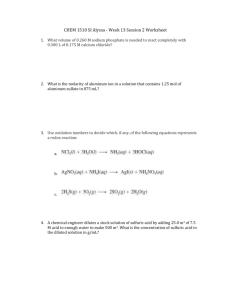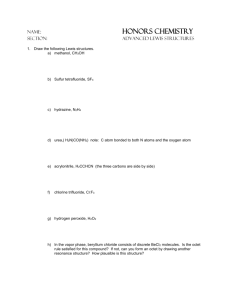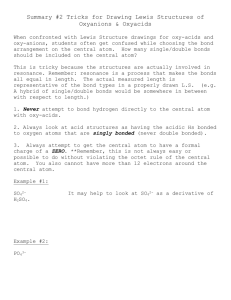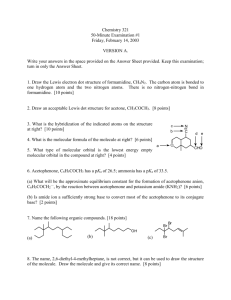MIT OpenCourseWare 6.189 Multicore Programming Primer, January (IAP) 2007
advertisement
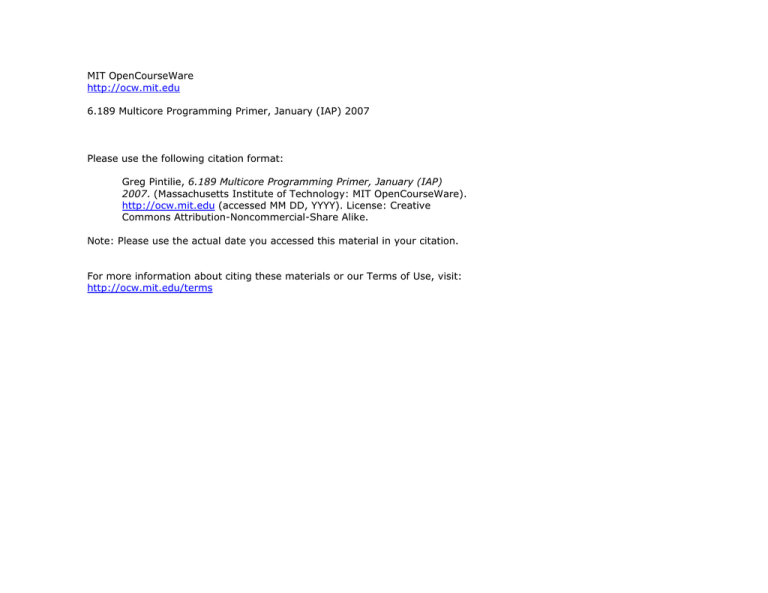
MIT OpenCourseWare http://ocw.mit.edu 6.189 Multicore Programming Primer, January (IAP) 2007 Please use the following citation format: Greg Pintilie, 6.189 Multicore Programming Primer, January (IAP) 2007. (Massachusetts Institute of Technology: MIT OpenCourseWare). http://ocw.mit.edu (accessed MM DD, YYYY). License: Creative Commons Attribution-Noncommercial-Share Alike. Note: Please use the actual date you accessed this material in your citation. For more information about citing these materials or our Terms of Use, visit: http://ocw.mit.edu/terms 6.189 IAP 2007 Student Project Presentation Molecular Dynamics Pintilie 6.189 IAP 2007 MIT Molecular Dynamics on the Playstation 3 Greg Pintilie Overview • Molecular Dynamics • Algorithm • Parallelization Approaches Molecular Dynamics • Potential Energy: v E p ( x ) = E bonded + E non−bonded Molecular Dynamics • Potential Energy: v E p ( x ) = E bonded + E non−bonded Ebonded = Ebonds + Eangles + Edih,imp Molecular Dynamics • Potential Energy: v E p ( x ) = E bonded + E non−bonded Ebonded = Ebonds + Eangles + Edih,imp Ebonds = ∑ k (l − l ) 2 b bonds 0 Molecular Dynamics • Potential Energy: v E p ( x ) = E bonded + E non−bonded Ebonded = Ebonds + Eangles + Edih,imp E angles = ∑ kθ (θ − θ ) 0 angles 2 Molecular Dynamics • Potential Energy: v E p ( x ) = E bonded + E non−bonded Ebonded = Ebonds + Eangles + Edih,imp Fdih ,imp = ∑ kφ (1− cos(nφ )) + kθ (θ − θ ) + ∑ kω (ω − ω ) 0 dihedrals 0 impropers Molecular Dynamics • Potential Energy: v E p ( x ) = E bonded + E non−bonded Ebonded = Ebonds + Eangles + Edih,imp E bonds = ∑ k (b − b ) b 2 0 bonds E angles = ∑ kθ (θ − θ ) 2 0 angles Fdih,imp = ∑ kφ (1− cos(nφ )) + kθ (θ − θ ) + ∑ kω (ω − ω ) 0 dihedrals 0 impropers Molecular Dynamics • Potential Energy: v E p ( x ) = E bonded + E non−bonded E non−bonded = E van−der −Waals + E electrostatic Molecular Dynamics • Potential Energy: v E p ( x ) = E bonded + E non−bonded E non−bonded = E van−der −Waals + E electrostatic E van−der−Waals ⎛ Aik Cik ⎞ = ∑ ⎜⎜ 12 − 6 ⎟⎟ rik ⎠ atoms _ i,k ⎝ rik Molecular Dynamics • Potential Energy: v E p ( x ) = E bonded + E non−bonded E non −bonded = E van − der −Waals + E electrostatic E van−der−Waals Eelectrostatic ⎛ Aik Cik ⎞ = ∑ ⎜⎜ 12 − 6 ⎟⎟ rik ⎠ atoms _ i,k ⎝ rik qi q k = ∑ atoms _ i,k Drik Molecular Dynamics • Compute forces : v ∂ v v f (t) = Ma (t ) = − v E p ( x ) ∂x • Integrate to obtain velocity, position: v f (t ) v⎛ 1 ⎞ ⎛ 1 ⎞ v ⎜ t+ Δt ⎟ = v⎜ t − Δt ⎟ + Δt m ⎝ 2 ⎠ ⎝ 2 ⎠ v v v ⎛ 1 ⎞ x (t + Δt ) = x (t ) + Δt ⋅ v ⎜ t + Δt ⎟ ⎝ 2 ⎠ Kinetic Energy • Kinetic Energy/Temperature: – from classical equipartition theory, each degree of freedom has, at thermal equilibrium, this much energy: 1 2 Ek k BT 1 3N 1 2 = ∑ mi v i = N F k B T 2 i=1 2 Langevin Dynamics • Account for collisions with imaginary molecules (heat bath) • e.g. in solvent such as water v v F = Ma = −∇E p ( x ) − γMv + R(t) R(t) =0 R(t), R(t') T =2γk B TMδ (t − t') Solvation in Dielectric Material • Molecules that are polar/ionic ‘shield’ electrostatic forces • Water: – distance-dependent dielectric: qi q k Eelectrostatic = ∑ atoms _ i,k Drik D = r E electrostatic = ∑ atoms _ i,k qi q k rik 2 Non-bonded Cut-offs E non− bonded • Cut-off ~12A ⎧⎪⎛ Aik C ik ⎞ q i q k ⎫⎪ = ∑ ⎨⎜⎜ 12 − 6 ⎟⎟ + ⎬ rik ⎠ Drik ⎪⎭ atoms _ i,k ⎪ ⎩ ⎝ rik Non-bonded Cut-offs E non− bonded • Cut-off ~12A ⎧⎪⎛ Aik C ik ⎞ q i q k ⎫⎪ = ∑ ⎨⎜⎜ 12 − 6 ⎟⎟ + ⎬ rik ⎠ Drik ⎪⎭ atoms _ i,k ⎪ ⎩ ⎝ rik Basic MD Algorithm For i=0 to numsteps if i % ap_freq == 0 find atom pairs Compute ‘bonded’ forces bonds, angles, dihedrals, impropers Compute ‘non-bonded’ forces atom pairs Integrate Data Structures Bonded Forces Bond Vector Atom *a1, *a2 double k, b0 double x, y, z Atom Vector pos, vel, force double Mass double Charge double Rmin double Eps Molecule list Atom atoms list Bond bonds list Angle angles list Improper impropers list Dihedrals dihedrals list AtomPair atompairs Angle Atom *a1, *a2, *a3 double k, t0 Improper Atom *a1, *a2, *a3, *a4 double k, t0 Dihedral Atom *a1, *a2, *a3, *a4 list DihedralValue vals DihedralValue double k, phase int n Non-Bonded Forces Atom Pair Atom *a1, *a2 double eij • A8m – ‘Bonded’ - total 41,652 • • • • 146 atoms x 104 bytes = 15,184 147 bonds x 24 bytes= 3,528 275 angles x 28 bytes = 7,700 393 dihedrals x 16 bytes + 414 dihedral values x 20 bytes = 14,568 • 21 impropers 32 bytes = 672 – ‘Non-bonded’ – total 176,000 • 11,000 Atom Pairs x 16 bytes – (1-3 bonded atoms excluded) • 10 x A8m – ‘Bonded’ – total 416,520 – ‘Non-bonded’ – total 16,976,000 • 20 x A8m – ‘Bonded’ – total 833,040 – ‘Non-bonded’ – total 68,064,000 Sequential Algorithm No cutoff With cutoff if i%ap_freq==0 find atom pairs 0 ms Bf / Kd 6,090 / 880 ms 24,440 / 1,750 ms ‘bonded’ forces bonds, angles, dihedrals, impropers 50ms 50ms ‘non-bonded’ forces atom pairs 1,480ms 150ms 1,060,850 pairs 116,434 pairs integrate 10ms 10ms For i=0 to numsteps Parallelization Approaches • Force Decomposition A1 A2 … A1 A2 A1 A3 … … • force operation includes both atom positions, returns the force on both atoms • scales well with system size and #processors An … … Parallelization Approaches • Force Decomposition iter 0 PPU for j=0 to #SPUs A1 A2 A1 A3 … … •send control block to SPU-j for step i=0 to num steps iter 1 •compute bonded forces •compute non-bonded forces • while non-bonded operations remaining • for j=0 to #SPUs • create block with force-operations (200) • send control block with #ops to SPU-j • tell SPU-j to start processing … … • for j=0 to #SPUs • if SPU-j finished, add forces to atoms • break if all SPUs finished • integrate forces iter 2 Parallelization Approaches • Force Decomposition - performance PPU 1SPU 2SPUs 3SPUs 4SPUs 5SPUs 6SPUs 310 630 390 310 280 270 260 Non-bonded Forces Computation Time 700 600 500 400 ms 300 200 100 0 PPU 1SPU 2SPUs 3SPUs 4SPUs 5SPUs 6SPUs Parallelization Approaches • Atomic Decomposition A1 A1 A2 A1 A3 … … A2 … • atoms and forces stored independently • doesn’t scale as easily with system size An … … Parallelization Approaches • Spatial Decomposition • not load-balanced • atom positions must be communicated between processors • periodically re-assign atoms State of the Art - NAMD • force-spatial decomposition Images removed due to copyright restrictions.

